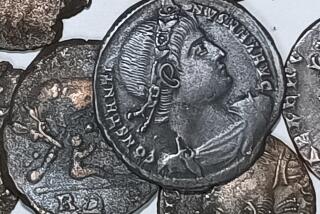Developments in Brief : Coin May Be Oldest From Europe in U.S.
- Share via
An ancient copper coin found at the winter campsite of Spanish explorer Hernando De Soto may be the oldest European-minted coin ever found in North America, archeologists said last week.
The coin, about 475 years old, was found less than a mile from Florida’s Capitol in Tallahassee. Archeologists have been digging at the site since construction workers unearthed Indian and Spanish artifacts in March.
The coin was minted in Spain between 1505 and 1517 for use in the major colonial city of Santo Domingo on the island of Hispaniola, now the Dominican Republic and Haiti, state archeologist Jim Miller said. “It is an exciting center of focus on the De Soto site. It confirms something we were already comfortable with--that this is the site of Hernando De Soto’s winter campsite.”
He added: “I can’t say it is the oldest without knowing what every other coin that has been found is. But there cannot be many older coins.”
The coin, called a “4 maravedi,” was the lowest denomination minted at the time. Similar coins have been found at four sites in the Caribbean basin, including Santa Domingo.
The coins were minted in Spain during the reign of King Ferdinand and Queen Isabela.
De Soto began his expedition with 600 to 700 men hoping to find the fabled golden riches of the New World. Four years later, after disastrous run-ins with Indians, disease and the dangers of the untamed North American continent, about 300 survivors staggered into Spanish colonies in Mexico. De Soto himself did not survive the journey.
More to Read
Sign up for Essential California
The most important California stories and recommendations in your inbox every morning.
You may occasionally receive promotional content from the Los Angeles Times.










